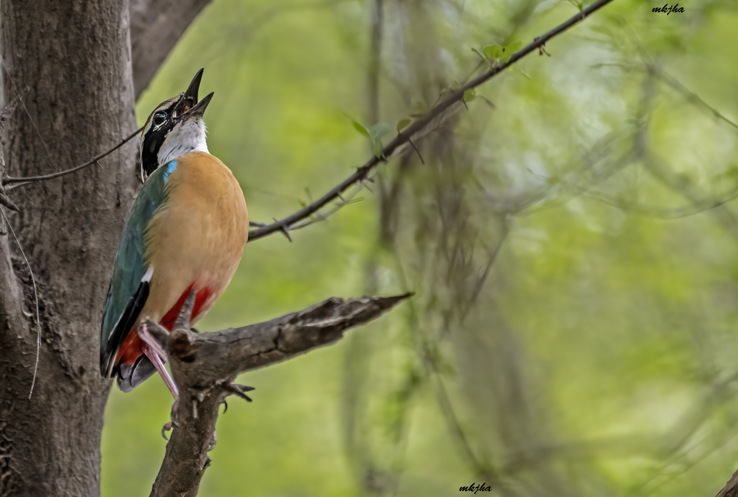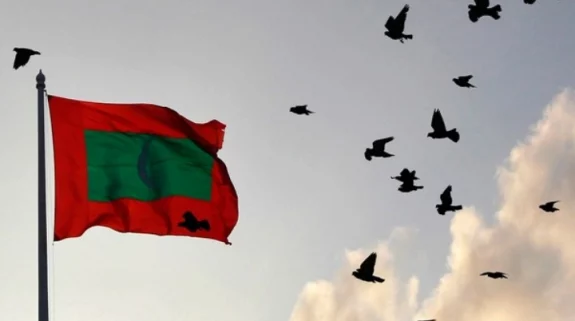I got a nice Holi Greeting card with a picture of a beautiful bird. It says: “May your life be as colourful as the nine coloured Navrang.”
Nine colours – brown, black, white, green, blue, orange, pink, red, buff. A buff-coloured crown stripe, black coronal stripes, a thick black eye stripe and white throat and neck. The upperparts are green, with a blue tail, the underparts buff, with bright red on the lower belly and vent. The colours of the pitta are emblematic of the kind of hues associated with India–deep yellow, flaming orange, turquoise, emerald green–bold, unapologetic colours. Colours you would find on the houses of village walls and saree pallus. The Indian Pitta calls with its head up towards the sky, often together or in pairs, charming the woods with sweet music.
The Pitta in the Indian Pitta comes from the Telugu word meaning “small bird”. Since this beauty travels across the peninsula, it has earned local names in many languages—Hindi, Naorang; Punjabi, Nauranga; Bengali, Shumcha; Gujarati, Navaranga or Hariyo; Tamil, Aru-mani kuruvi, Kathelachi, Thotta kallan; Telugu, Polanki pitta, Ponnangi pitta; Malayalam, Kavi; Kannada, Navaranga and in Sinhalese, Avichchiya.

The Indian Pitta is a shy bird (Photo: Kamal Sahansi)
Of all these, it is the Tamil name which is particularly interesting. It’s called the ‘aru-mani kuruvi’, which translates to the “6-o-clock bird.” This bird is vocal, giving its characteristic two-noted whistle call at dusk and dawn, hence the name.
According to a Sinhala legend, the bird was formerly a prince who was deeply in love with a beautiful princess. His father sent him to travel for some years, and on his return the princess was dead. He wanders disconsolately calling her name.
Another story says the peacock, being a bird of sober plumage, borrowed the brilliant coat of the Pitta to attend a wedding, and did not return it. The disconsolate Pitta wanders through the jungle calling on the peacock to restore its dress, all the while complaining about the theft of its dress by a peacock: “Evith giya, evith giya, ayith kiyannam, methe budun buduwana vita ayith kiyannam”, which translates as: "Came and went! Came and went! I'll still be complaining when the next Buddha comes! I'll still be complaining.”
The Indian Pitta has been a dream bird for me since I started birding two years ago and finally saw one in Bhondsi, Gurugram, during the lockdown. We heard the melodious call “wheet-teuu” and followed the source of that distinct two-note whistle. There it was – the colourful Indian Pitta perching on a tree branch. Its two-note whistle, that is repeated after a noticeable gap, is hard to miss. This was the commencement of the breeding season and the birds become increasingly vocal right up till the end of June. The Pitta is not sighted easily in urban clusters though the bird is heard very often in the Aravali range of the NCR.
The Pitta’s typical behaviour is to walk on ground, upturning leaf litter to gobble insects. It is otherwise a shy bird, loathe to reveal itself in human presence and prefers singing from leafy boughs. The Pitta's call is easily heard but it seems to reserve a viewing of its mosaic of colours for pretty females.
I was curious about Indian Pitta’s two calls—the one at sunrise and the other at sunset.
Experts say, “they call in the morning and evening to mark their presence and territory. They want to announce to the other Pittas that they do not want them to unnecessarily come and poke around in their territory. It is to send out the signal that this place is occupied.”
Experts say that the bird, Navrang, inhabits deep-dense forests and green jungles where it forages on forest floors with thick undergrowth, catching insects in the leaf litter. The flock disperses into the forests of lower Himalayas, central and western India for breeding between the months of May to July. In winters during September and October they migrate to the southern peninsula and Sri Lanka.
When the Pittas reach Sri Lanka, they are completely exhausted by the flight over the Palk Strait and the reverse migration to their breeding areas in the north takes an equal toll on them.




















